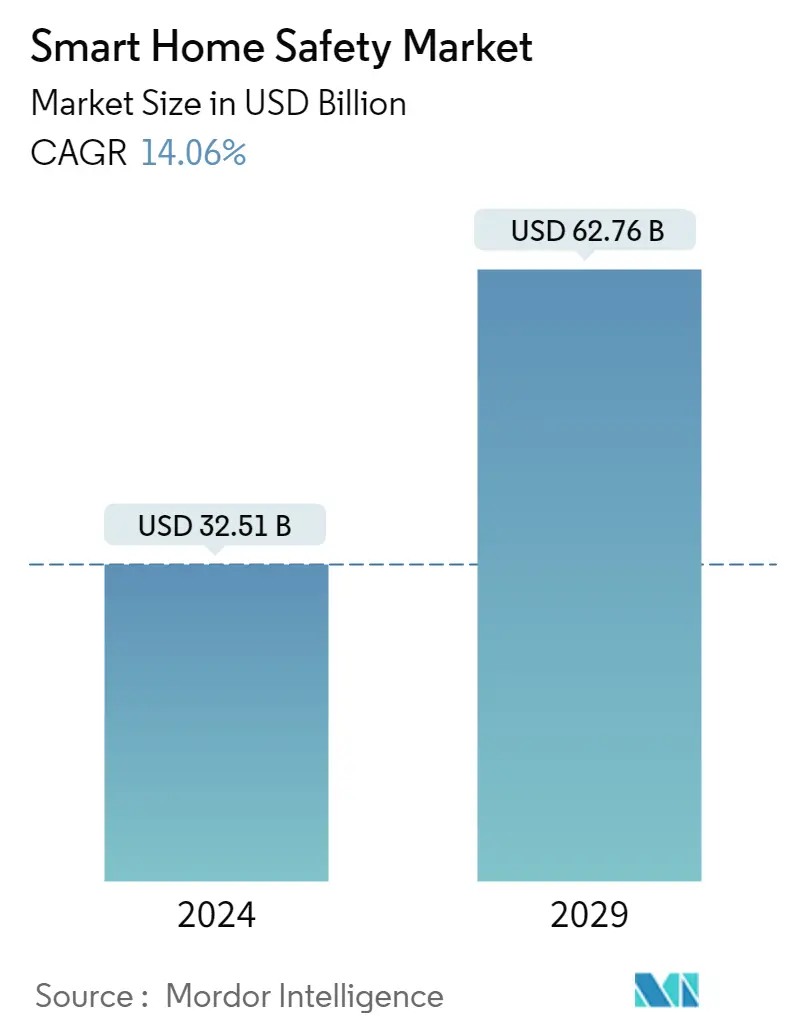Market Size of Smart Home Safety Industry

| Study Period | 2019 - 2029 |
| Market Size (2024) | USD 32.51 Billion |
| Market Size (2029) | USD 62.76 Billion |
| CAGR (2024 - 2029) | 14.06 % |
| Fastest Growing Market | Asia Pacific |
| Largest Market | Asia Pacific |
Major Players.webp)
*Disclaimer: Major Players sorted in no particular order |
Need a report that reflects how COVID-19 has impacted this market and its growth?
Smart Home Safety Market Analysis
The Smart Home Safety Market size is estimated at USD 32.51 billion in 2024, and is expected to reach USD 62.76 billion by 2029, growing at a CAGR of 14.06% during the forecast period (2024-2029).
Smart home safety devices have been gaining popularity in recent years as more and more people seek to make their homes safer and more secure. These devices use advanced technology to provide a range of safety features, such as home security cameras, smoke detectors, and smart locks, that can be controlled remotely using a smartphone or other mobile device. One of the main advantages of smart home safety devices is that they allow homeowners to monitor their homes from anywhere in the world and also help to prevent accidents and emergencies from occurring in the first place.
- Smart home safety devices can be connected to Wi-Fi and accessed from anywhere using smart devices, such as smartphones, smartwatches, or voices. The smart home safety market is driven by the increasing crime rates worldwide, forcing people to focus on security and safety systems, especially in residential areas.
- According to the Forbes Magazine, on average, over one million home burglaries happen annually in the U.S. and property crimes are the most common type of crime in the U.S. Notably, americans spend over USD 20 billion annually on security devices and systems to protect themselves and their property.
- Furthermore, a majority of burglars or home invaders significantly choose the path of least resistance to commit their crime. For instance, locked doors and windows are only a slight deterrent for most criminals. Thus, home security systems, especially ones that incorporate exterior cameras, motion detection and adequate lighting, are considered the best criminal deterrents. As per the US News home security survey done in 2022, about 2,000 U.S.having home security cameras pension the leading reason to do self-protection followed by another answer which was to deter criminals.
- According to The whitepaper, Home Security: Choice is the Ultimate Value Proposition, DIY-installed security systems, like Ring Alarm, SimpliSafe and Abode, and DIY offerings from national brands such as Comcast and ADT, have expanded consumer familiarity with the category. Moreover, a growing number of consumers are seeking affordable, easy-to-install solutions to protect their homes.
- With the growing adoption of smart home devices, including safety devices, data leaks have also been observed to have increased significantly. This has been led by using ransomware and phishing to expose personally identifiable information. Therefore, customers are expected to continue to prioritize privacy for smart home safety solution adoption, which is a key restraining factor to the studied market's growth.
- The smart home security market has observed a significant impact of COVID-19 as some householders were reluctant to risk exposure to COVID-19, avoiding connection and even repair technicians entering their homes, but heightening the inclination to acquire self-install security systems. Thus, housing customers wanted to increase their sense of security while at home, due to which the smart home security market became a huge opportunity.
